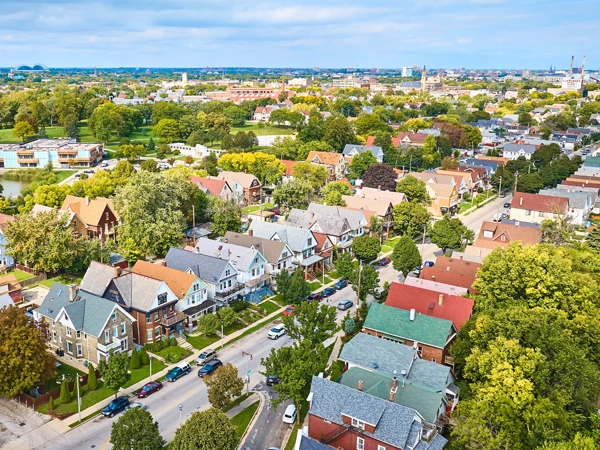
This article was written by Sage Computing Inc, under contract with the U.S. Department of Housing and Urban Development. The contents of this article are the views of the author(s) and do not necessarily reflect the views or policies of the U.S. Department of Housing and Urban Development or the U.S. Government.
The Joint Center for Housing Studies (JCHS) of Harvard University released “The State of the Nation’s Housing 2024,” which presents insight and data on how high housing costs are affecting households and housing markets. On June 20, 2024, JCHS held a virtual event to present the report’s findings and host a panel discussion. Chris Herbert, managing director of JCHS, opened the event, and Daniel McCue, senior research associate at JCHS, presented a high-level summary of the report. McCue’s presentation was followed by a panel discussion moderated by Jennifer Ludden, National Desk correspondent at National Public Radio. The panelists included Priya Jayachandran, chief executive officer of the National Housing Trust; Chrystal Kornegay, chief executive officer of MassHousing; and Sheryl Palmer, chairman and chief executive officer of Taylor Morrison.
Cost Burdened Renters Have Increased Across Various Income Levels
As rents have continued to rise, the number of renters that are cost burdened — those spending more than 30 percent of income on rent — has reached an all-time high. McCue shared findings from the report, which reveals that more than 22 million renter households were cost burdened in 2022. These numbers include middle-income households earning between $45,000 and $75,000 annually, the fastest-growing group to experience housing cost burdens. Herbert explained that 10 to 15 years ago, affordability pressure was broadly attributed to very low-income people experiencing difficulty paying their rent. Today, 41 percent of middle-income renter households are cost burdened. The number of cost burdened households becoming more widespread across various income brackets has attracted attention from policymakers at the state and local level. Herbert emphasized that, with the lack of subsidy money available to directly support middle-income households, solutions such as regulatory reform and streamlining private-sector production of low-cost housing are needed.
Even so, Herbert stressed that policymakers must remain focused on expanding the housing safety net for the lower-income households, who experience the greatest financial stress that more severely affects well-being. While high housing costs may limit middle-income households’ ability to save or spend on groceries and dining out, very low-income households face tougher tradeoffs. These households are more likely to face choices that exacerbate existing threats to health and financial stability, such as missing meals or relocating to substandard housing.
Expanding the Housing Safety Net
The report attributes decreased rental affordability to a combination of strong rental demand — fueled by Generation Z population growth and the growing number of higher-income renter households — and a decreasing stock of low-cost rental units. Between 2012 and 2022, the rental market lost 6.1 million units with monthly rents of less than $1,000. Although additional affordable housing was built during the same period, these new construction units tend to come with higher rents, and preserving low-rent housing is critical. Preserving these affordable units does not come without challenges, however, and Jayachandran stated that the existing low-rent units are “vulnerable to [pressures ranging from] high operating costs and no ability to reinvest in the properties… to pressures to convert from affordable housing to market rate… to physical obsolescence.”
In addition to preserving low-rent housing, the panelists agreed that increasing the amount of federal assistance is crucial to expanding the housing safety net. HUD’s measure of worst case housing needs, which is defined as the number of very low-income households that are not receiving federal assistance despite living in severely inadequate housing or paying more than half of their income for rent, has increased from 5 million to 8.5 million over the past 20 years. At the same time, for decades, federal subsidies have fallen short in serving those who are inadequately housed. The report states that as of 2022, rental assistance currently serves 5.1 million households, but the nation has 22.4 million cost burdened renter households. Jayachandran suggested that these demographic changes show that the affordable housing problem is not only a supply-side deficiency but also a demand-side issue that requires federal rental assistance to be “massively readjusted.”
Homeownership Gap Disparities Persist
The report also shed light on how the housing market has affected homeowners and potential homebuyers. Rapid price appreciation has increased aggregate homeowner equity by 37 percent over the past 4 years. At the same time, the inventory of homes for sale is at a record low, a result of the “lock-in” effect in which homeowners are disincentivized to sell because they do not want to lose the low mortgage interest rates they have for their current homes. Unfortunately, high home prices have put homeownership out of reach for all but the highest-income households. According to the report, rising home prices and high interest rates require a minimum income of at least $100,000 to afford the median-priced home in nearly half of all metropolitan areas. Still, the low-downpayment mortgages that first-time homebuyers often pursue come with the tradeoff of slightly more than $3,000 in monthly payments after taxes and insurance for a median-priced home. Palmer states that with increased co-signing and rate buydowns, Taylor Morrison staff are seeing “the Bank of Mom and Dad in our sales and our closings at a higher rate than we’ve ever seen before.”
The report states that households of color experience disadvantages that include “a lack of access to the intergenerational transfers of wealth that serve as a downpayment for many white homebuyers.” Kornegay expanded on these disadvantages to highlight how historic institutional racism has created barriers to homeownership and that income inequality should not be conflated with racial inequality. For example, Kornegay stated that in Massachusetts, Black households are more likely to be denied a mortgage even if their income is greater than $75,000 annually. This acknowledgment has led MassHousing to consider where people of color live and purchase homes to create more targeted solutions for homeownership production and downpayment assistance. Kornegay also explains that special-purpose credit programs, which acknowledge the existence of barriers outside of income and credit, are necessary for reducing the racial homeownership gap.
Housing and Climate Resiliency
The panelists discussed the growing threat of climate change and strategies for resiliency for rental units and single-family owned homes. Billion-dollar disaster events related to climate change have become 9 times more frequent since the 1980s, with 28 such events occurring in 2023 alone. As the number of climate-related disasters continues to rise, the costs to cover housing damage have also risen. According to the Federal Emergency Management Agency’s National Risk Index, more than 60 million units are in areas of at least moderate risk. Jayachandran focused on the existing stock of affordable housing that is vulnerable to extreme weather events. She said that because affordable housing historically has been intentionally relegated to vulnerable areas, policymakers need to exercise “equal intentionality” to relocate this housing to safer areas.
The report also discussed the challenges associated with reducing the residential carbon footprint, which amounts to 18 percent of the country’s greenhouse gas emissions. One key strategy — retrofitting older housing — also lowers energy costs in the long run; however, Kornegay explained that the costs of retrofits are a barrier for low-income homeowners. Recognizing this burden for these households, the federal government allocated $9 billion under the Inflation Reduction Act of 2022 to rebate programs for energy-efficient technologies for single-family residences. The act also supports affordable multifamily housing by expanding existing tax credit programs and allocates an additional $1 billion for the Green and Resilient Retrofit Program to fund sustainability improvements in HUD-assisted housing.
A Crisis of Multiple Players
The report underscored how the housing affordability crisis impacts households across all income levels and demographics, and the panelists emphasized the need for expanded federal assistance and equitable homeownership opportunities. Furthermore, the effects of climate change and the contribution of residential areas to the country’s carbon footprint require resilient housing with targeted assistance at various income levels. The panelists agreed that the solutions are multifaceted and require multiple stakeholders to expand the housing safety net for renters and homeowners.



